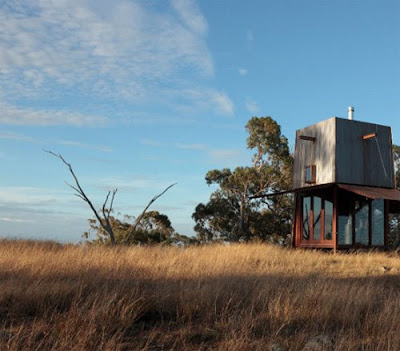One person who left a comment on one of our posts about the Tea fire near Santa Barbara and Montecito writes a blog called "Blissful Ignorance". He has a house very close to the point of origin of the fire and wrote a very interesting article about his experiences. You should read it.
Wildfire-proof structure for remote area

Do you need a fire-proof cabin for your country retreat? Architect Casey Brown has designed a prefabricated, copper clad, structure that could be moved onto your vacation spot. As long as you live in Australia.

More information is HERE.
Washington: Airborne ignition device falls into Costco parking lot
From the Spokesman-Review in Spokane, Washington:
Spokane Valley firefighters want to know more about a nighttime UFO that dropped fireballs onto the Costco parking lot. Witnesses reported seeing two fireballs fall from the sky about 6:40 p.m. Nov. 6 at the Costco store at 5601 E. Sprague Ave., but investigators theorize that both came from the same airborne device.Hopefully firefighters will not be plagued with this as a new fire threat. It might remind you of the fire balloons launched by Japan against the U.S. during World War II.
Deputy Fire Marshal Bill Clifford said firefighters found a charred aluminum beverage can that had been cut open on one side to form a sort of "canoe." He said investigators speculate that the can was suspended horizontally, like a gondola, from a helium-filled balloon. Remnants of wadded paper towels or cloth were found stuck to the container.
The burning material and a pool of flammable liquid may have fallen in two pieces when fire caused the device to break apart, Clifford said.
Although it was raining when the fireballs fell, they could have injured someone or ignited a fire on the ground. A wildfire could have been sparked if the device had drifted over timberland in dry weather, Clifford said.
He said the charred can is being held as evidence, but any fingerprints probably were burned away.
Not surprisingly, it's illegal to launch such a flying firebomb. The likely charge would be reckless burning.
Between November 1944 and April 1945, Japan launched over 9,000 fire balloons toward the American mainland. Carried by the recently-discovered Pacific jet stream, they were to sail over the Pacific Ocean and land in North America, where the Japanese hoped they would start forest fires and wreak devastation.Was Wag Dodge an Einstein?
About three hundred were reported as reaching North America, but little damage was caused. Six people – five children and their mother Elise Mitchell – became the only deaths due to enemy action to occur on mainland America during World War II when one of the children tried to recover a balloon from a tree near Bly, Oregon and it exploded. Recently released R.C.M.P. and Canadian military reports indicate that fire balloons got as far inland as the rural area near Ituna Saskatchewan.
On the Mann Gulch fire in 1949 the smokejumper supervisor, Wag Dodge, lit an escape fire, stepped into it and survived, while most of the rest of his crew did not. Here is an excerpt from an interesting article in the Times in the UK about the human brain, and how there might be some genius in all of us. (Well.... not ALL of us. I could give you some exceptions that prove the rule... but don't get me started.)
At 6pm on August 5, 1949, a fireman named Wag Dodge and his crew found themselves cut off by a wildfire in Mann Gulch River Valley, Montana. A wall of flame was coming towards them at 30 mph. Dodge took a match out of his pocket and set fire to the grass immediately in front of him, stepped into the cleared space, covered his face and pressed himself into the ground so that he could breathe the thin layer of air beneath the smoke cloud. The fire rushed over him and he survived. The other 13 members of the crew hadn’t heard his order to do the same. They all died. [Two other crew members outran the fire and survived. B. Gabbert]
Like the story of Phineas Gage, the story of Wag Dodge has become an inspiration to neuroscientists. Why and how did he do what he did under such extreme conditions? “Wag Dodge — he’s a great one,” says Mark Jung Beeman, a professor of psychology at Northwestern University in Illinois. “It was particularly interesting in such a stressful situation. He was at the point where he basically gave up. He must have had some pretty awesome frontal lobes. Normally, high stress would limit creative, flexible or insight-type thinking, but not in this case.” Beeman’s phrase “at the point where he basically gave up” is crucial. Dodge had been struggling to find a way to escape the flames for some time. When, finally, the situation seemed to be hopeless, it is thought he had a moment of relaxation, of giving up, and that moment became his eureka moment.




2 comments:
Casey's fire-proof structure? What a crock! If you want to die order one today. In the Victorian fires in Australia in 2009 the intensity was so strong the doors of fireproof concrete bunkers twisted. Houses instantaneously combusted. Trucks melted. That thing would be the first amenity to burn!
If we are serious about re-building in bush fire prone areas, then proper consideration should be given to properly designed and constructed public disater shelters, (which would require government maintainence), and/or private home emergency shelters (to be built as part of issuing the building permit). They only need to provide shelter for a couple of hours at the most.
Post a Comment